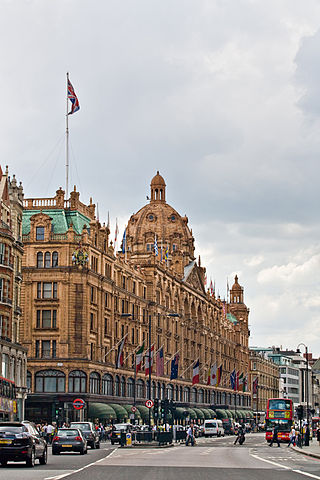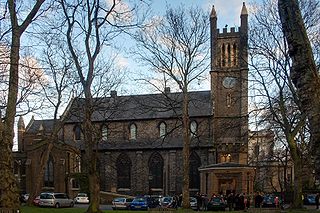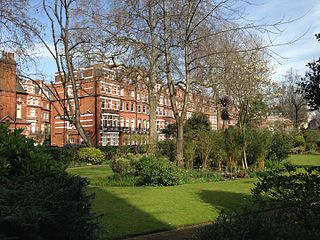
Knightsbridge is a residential and retail district in central London, south of Hyde Park. It is identified in the London Plan as one of two international retail centres in London, alongside the West End. Knightsbridge is also the name of the roadway which runs near the south side of Hyde Park from Hyde Park Corner.

Sir Leslie Stephen was an English author, critic, historian, biographer, mountaineer, and an early humanist activist. He was also the father of Virginia Woolf and Vanessa Bell.
Earl's Court is a district of Kensington in the Royal Borough of Kensington and Chelsea in West London, bordering the rail tracks of the West London line and District line that separate it from the ancient borough of Fulham to the west, the sub-districts of South Kensington to the east, Chelsea to the south and Kensington to the northeast. It lent its name to the now defunct eponymous pleasure grounds opened in 1887 followed by the pre–World War II Earls Court Exhibition Centre, as one of the country's largest indoor arenas and a popular concert venue, until its closure in 2014.

Elias George Basevi FRS was a British architect who worked in both Neoclassical and Gothic Revival styles. A pupil of Sir John Soane, his designs included Belgrave Square in London, and the Fitzwilliam Museum in Cambridge. He was surveyor to the Guardian Assurance Company, to the Trustees of Smith's Charity and to the Thurloe estate.

South Kensington is a district just west of Central London in the Royal Borough of Kensington and Chelsea. Historically it settled on part of the scattered Middlesex village of Brompton. Its name was supplanted with the advent of the railways in the late 19th century and the opening and naming of local tube stations. The area has many museums and cultural landmarks with a high number of visitors, such as the Natural History Museum, the Science Museum and the Victoria and Albert Museum. Adjacent affluent centres such as Knightsbridge, Chelsea and Kensington, have been considered as some of the most exclusive real estate in the world.

Holy Trinity Brompton with St Paul's, Onslow Square and St Augustine's, South Kensington, often referred to simply as HTB, is an Anglican church in London, England. The church consists of six sites: HTB Brompton Road, HTB Onslow Square, HTB Queen's Gate, HTB Courtfield Gardens, as well as being the home of the St Paul's Theological Centre and the Alpha Course, HTB St. Francis Dalgarno Way, and St Luke's Earls Court St Luke's Church Redcliffe Gardens. It is where the Alpha Course was first developed and is one of the most influential churches in the Church of England.

Brompton, sometimes called Old Brompton, survives in name as a ward in the Royal Borough of Kensington and Chelsea in London. Until the latter half of the 19th century it was a scattered village made up mostly of market gardens in the county of Middlesex. It lay south-east of the village of Kensington, abutting the parish of St Margaret's, Westminster at the hamlet of Knightsbridge to the north-east, with Little Chelsea to the south. It was bisected by the Fulham Turnpike, the main road westward out of London to the ancient parish of Fulham and on to Putney and Surrey. It saw its first parish church, Holy Trinity Brompton, only in 1829. Today the village has been comprehensively eclipsed by segmentation due principally to railway development culminating in London Underground lines, and its imposition of station names, including Knightsbridge, South Kensington and Gloucester Road as the names of stops during accelerated urbanisation, but lacking any cogent reference to local history and usage or distinctions from neighbouring settlements.

West Brompton is an area of west London, England, that straddles the boundary between the London Borough of Hammersmith and Fulham and Royal Borough of Kensington and Chelsea. The centuries-old boundary was traced by Counter's Creek, now lost beneath the West London Line railway.

Sir Charles James Freake, 1st Baronet was an untrained English architect and builder, responsible for many famous 19th-century façades in London, including Eaton Square, Exhibition Road and Onslow Square, mainly specialising in domestic architecture for wealthy clients. From humble beginnings and apprenticeship as a carpenter, he became a master builder, patron of the arts — especially music — and a philanthropist.

William Railton (1800–77) was an English architect, best known as the designer of Nelson's Column. He was based in London, with offices at 12 Regent Street for much of his career.

The Boltons is a street and garden square of lens shape in the Brompton district of the Royal Borough of Kensington and Chelsea, London, England. The opposing sides of the street face the communal gardens with large expansive houses and gardens, in what is considered the second most expensive street in the country with an average house price of £23.1m. The elliptical central gardens of the Boltons are Grade II listed on the Register of Historic Parks and Gardens.

St Paul's, Onslow Square, is a Grade II listed Anglican church in Onslow Square, South Kensington, London, England. The church was built in 1860, and the architect was James Edmeston. Composer William Carter was appointed organist at the church in 1868. Hanmer William Webb-Peploe (1837–1923), the evangelical clergyman, and member of the Holiness Movement, was the vicar for 43 years from 1876 to 1919.

James Bonnin was an English property developer who built more than three hundred houses in the Brompton, Kensington, Knightsbridge and Chelsea areas of London. In 1846, he was declared bankrupt, and decided to emigrate in 1849, but died a few days after arriving in Adelaide, South Australia.

St Augustine's, Queen's Gate, is a Grade II* listed Anglican church in Queen's Gate, Brompton, London, England. The church was built in 1865, and the architect was William Butterfield.

Pelham Crescent is a circa 1825 Georgian crescent of houses in South Kensington, London SW7, England, designed by architect George Basevi. Numbers 1–14 and 15–27 are separately Grade II* listed.

The Polish Hearth Club is a private members' club founded soon after the outbreak of World War II by the British Government and the Polish government-in-exile at 55 Princes Gate, Exhibition Road in the City of Westminster, London, close to the South Kensington museums, in a Grade II listed building. It was intended as a social meeting place for diplomats, the military cadre and other officials. The facilities included a restaurant,, a theatre and an exhibition space. It faces the main entrance to Imperial College London and is around the corner from the Polish Institute and Sikorski Museum, which was built as part of one development by Charles James Freake.

Brompton Square is a garden square in London's Brompton district, in the Royal Borough of Kensington and Chelsea.

Egerton Gardens is a street and communal garden, regionally termed a garden square, in South Kensington, London SW3.

1–5 and 6 Sydney Place, South Kensington, are a group of large terrace houses situated on the corner of Sydney Place and Fulham Road in London, United Kingdom. Sydney Place leads into Onslow Square. The buildings have been listed Grade II as a group on the National Heritage List for England since 1969.

Montpelier Square is a residential garden square in Knightsbridge, London, administratively in the City of Westminster. The homes were built in the 19th century and are of brick construction partly covered by stucco. All of the buildings facing inwards are listed grade II in the heritage listing scheme used in England.























